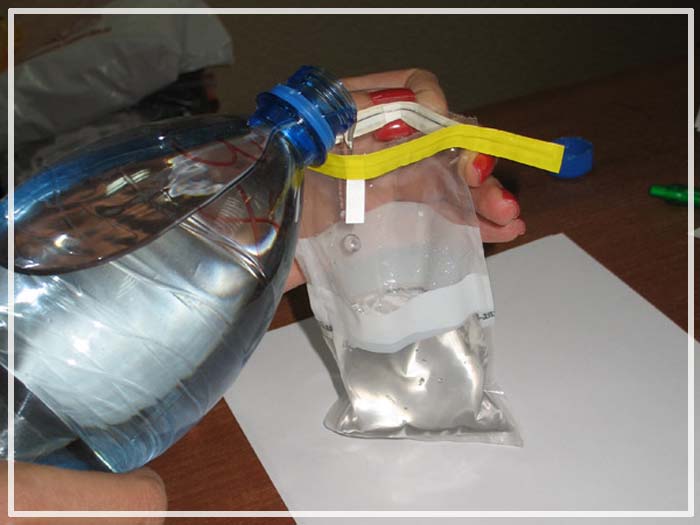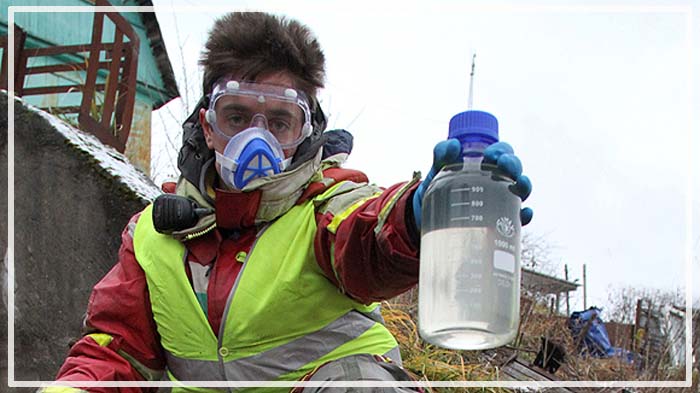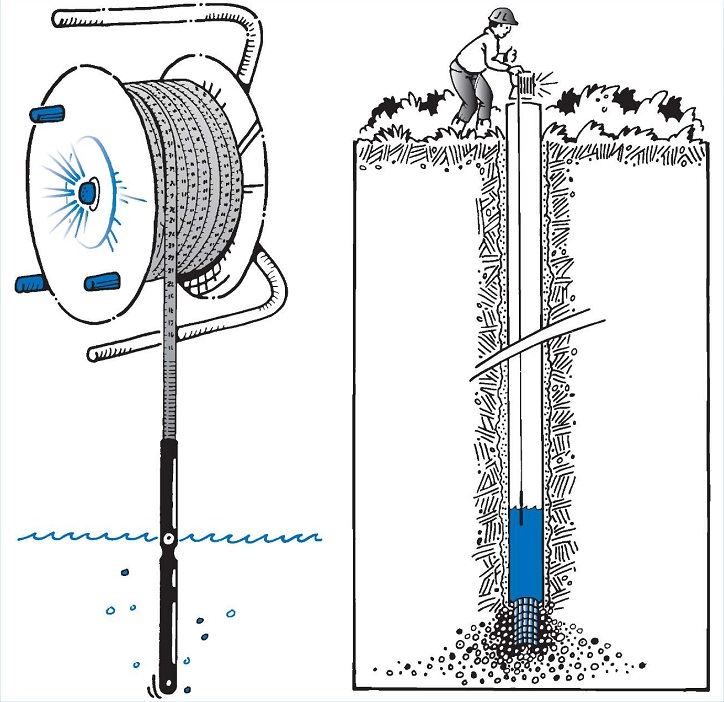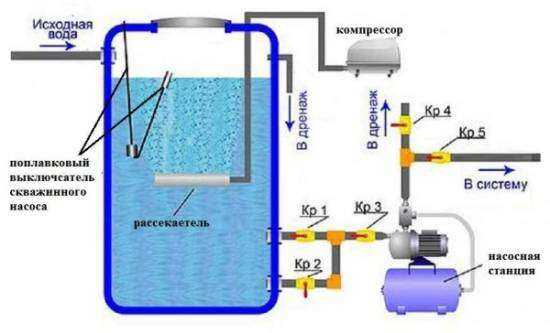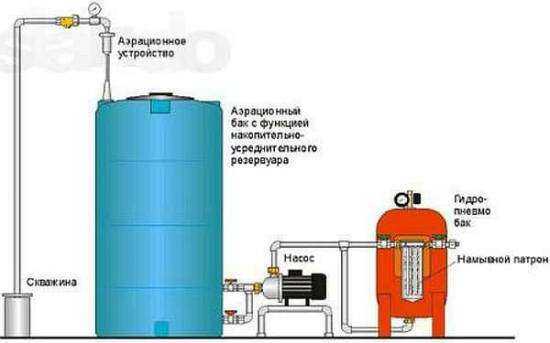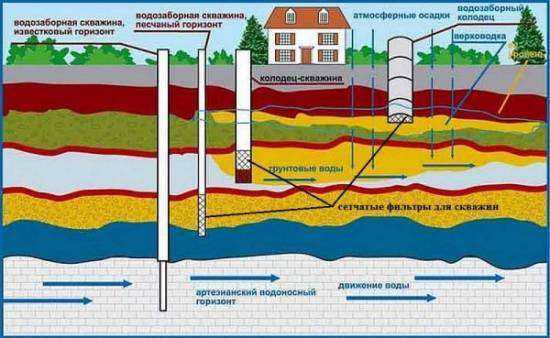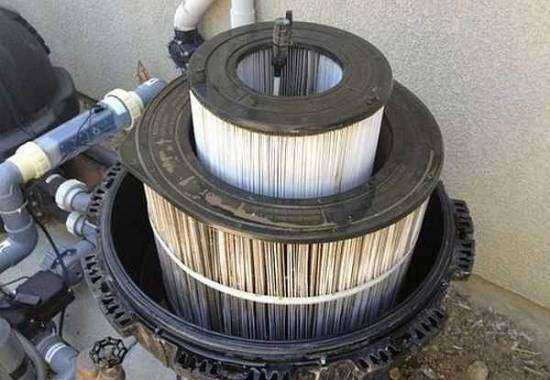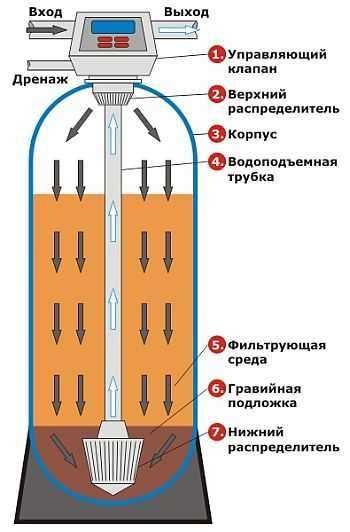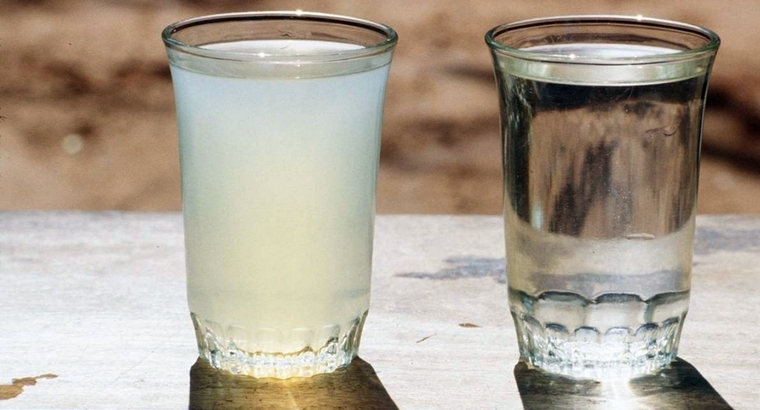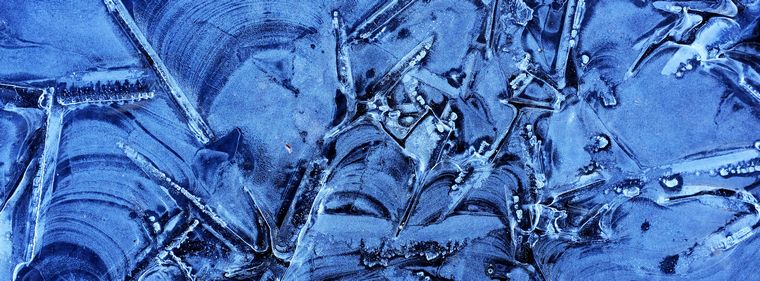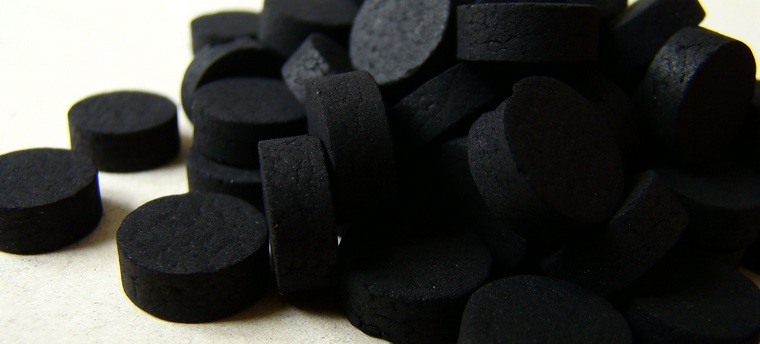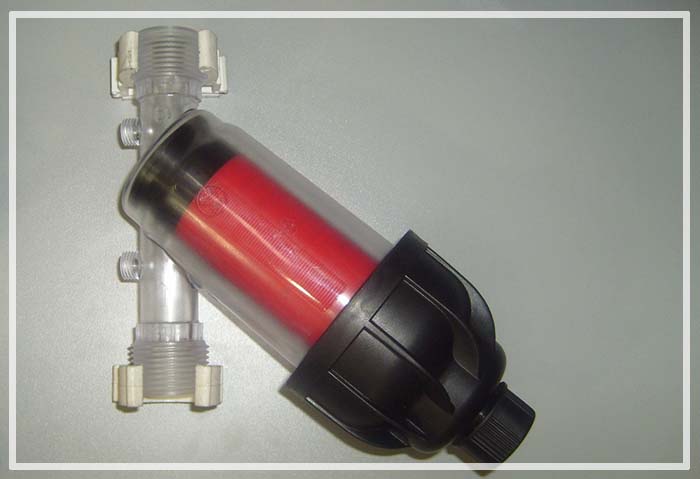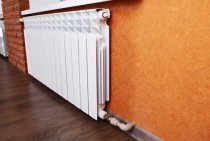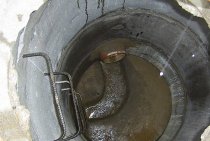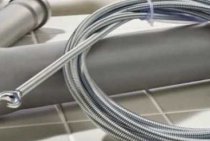Fluid collection for bacteriological examination
Analyzes for organoleptic and radiological impurities do not require such a thorough and thorough approach to material sampling
- For this analysis, you need to purchase exclusively sterile containers (as sanitary standards say).
- If your well is not new, it should be treated with sodium hypochlorite. The same applies to the new source.
- The tap from which water will be drawn must be burned or treated with medical alcohol.
- When taking liquid, do not touch the neck of the bottle with your hands (it is better to wear sterile gloves), and the neck of the tank - to the tap.
- After drinking water is taken, we tightly tighten the lid and send the water to the laboratory in a short time to identify its tank composition.
Proper water intake
You need to collect water directly under the very neck and tightly close the lid.
To analyze drinking water for quality and the presence of chemical impurities, it is necessary to strictly follow the recommendations that allow you to get the most accurate result of the study:
- The container or tank for water should be at least 2 liters, and it is desirable that it be a bottle of drinking water, but not from compote, juice or other liquids.
- Never wash the bottle/tank with any detergents. It is enough just to rinse the container with the water that you will hand over to the laboratory. We rinse the lid as well.
- According to sanitary standards, drinking water from the source should be taken only after a thorough descent for 20-30 minutes. In this case, all the already settled water will be drained, and water will come for analysis directly from the source.
- You need to collect water directly under the very neck and tightly close the lid. In this case, it is better if the material is taken in a thin stream along the wall of the bottle or tank. In this case, chemical reactions in drinking water will be minimized, and the result of the study will be as accurate as possible.
- According to sanitary standards, water should be delivered to the laboratory no later than 2 hours after the liquid was taken.
How and with what to measure water levels
Uninterrupted operation of the pump and fluid supply depend on the correct measurements. The difference between the 2 indicators, exceeding 1.2 m, forces us to look for the cause of the problem. A large difference may appear due to the ingress of contaminated fluid from the soil into the system and the penetration of impurities with sediment into the well.
All measurements must be carried out qualitatively. The measurement of the dynamic horizon is divided into several successive steps. In this case, the process will be noticeably simplified, there will be a smaller measurement error. It is recommended to determine the levels on hot days that were not interrupted by precipitation. Water should not be used within 1 hour.
How indicators are measured:
- You need a small load and a nylon thread. The load is securely fixed and lowered into the well to the very bottom.
- Then the thread is taken out and the length of its wet part is measured.
- A mark is placed on the border of the wet and dry areas. It must be done in such a way that it does not disappear under the influence of the liquid. You can use an indelible marker.
- The pump must then run for at least 60 minutes. The water horizon is bound to change.
- Then the thread with the load falls to the bottom again.
- Then the difference between the levels is measured. To do this, a new mark is placed, the distance between the first and second value is measured. The second result is the dynamic indicator of the level.
Based on the data obtained, an analysis of the performance of the well is carried out. The easiest way to evaluate the values obtained in dynamics is with the help of a computer program.In order for the wells to work normally, drilling technology should be observed. It must be produced in areas with a good aquifer.
Why does rusty water come out of the well?
"Brown" water often flows from the water well due to the penetration of its trivalent (colloidal) soluble iron. It is this compound that, after settling, forms a precipitate at the bottom of the tank, coloring the water in brown tones. In addition to ferric iron, water may contain a divalent form of the element, which is not able to affect transparency.
The reasons for the penetration of iron ions into the source are:
- activity of microorganisms;
- pipeline wear.
Whatever the reason for the deterioration of the quality of the liquid, it must be eliminated in order to obtain moisture that is safe for needs.
Normal water indicators
Water from individual sources and wells in laboratories is evaluated by such chemical elements and their indicators. See table.
Organoleptics (sanitary standards for an individual well):
| № | Name | Units | Sanitary standards |
| 1 | Smell | points | |
| 2 | Chroma | degrees | |
| 3 | Turbidity | 1Noc=0.58 mg/dm3 | |
| 4 | Taste and flavor | points |
Table of chemical indicators
| room | The name of the chemical element | unit of measurement | norm |
| 1 | Hydrogen | PH units | 6,5-8,5 |
| 2 | Iron | Mg/dm3 | |
| 3 | General hardness | mol/dm3 | |
| 4 | Manganese | Mg/dm3 | |
| 5 | sulfates | Mgdm3 | |
| 6 | Dry residue | Mg/dm3 | |
| 7 | Chlorine residual free | Mg/dm3 | |
| 8 | Chloride | Mgdm3 | |
| 9 | Residual chlorine bound | Mg/dm3 | |
| 10 | Ammonium | Mg/dm3 | |
| 11 | Nitrates | Mg/dm3 | |
| 12 | Nitrites | ||
| 13 | Fluorides |
https://youtube.com/watch?v=eEatnR_FMLk
What indicators of water are most important for a person
When there is an understanding of the need for verification, questions arise: what exactly is contained in our water, where should we go, what impurities should be eliminated first. Here we are faced with the choice of the organization conducting the analysis, with its competence and integrity.
Unfortunately, there are companies that sell filters and treatment plants that manipulate the results to push the inexperienced gardener into buying expensive equipment. If you have no time to study SanPiN and other regulatory documents, look at just two tables:
This is interesting: The roof of the balcony of the last floor is leaking - we state it point by point
Non-pressure aeration water treatment systems
The second type of aeration system is non-pressure. It has a large container in which water settles. The volume of the container is from 600 liters, but in general it depends on the water consumption: no more than 50-60% of the available volume should be consumed so that the sediment remains at the bottom.
Water is supplied to the tank directly from the well. The water level can be controlled by sensors - lower and upper levels or, as in the photo, a float switch of a borehole pump. To protect the system from overfilling, a water discharge pipe is made just above the critical level. It can go into the drainage or sewer system
It is important that there are some visual indicators that there is too much water in the tank.
Non-pressure aeration system for purification of water from a well from iron, manganese, other impurities and dissolved gases
Such a system works as follows: Water is drawn into the tank to the required level, after which the pump is turned off. To purify the water, a compressor (possibly powerful for aquariums) is turned on, which supplies air to the tank. It is distributed through the divider, which is located at about half the depth.
To ensure constant pressure in the system, water from the tank can be pumped out using a pumping station. Water is taken from the lower third, but not from the very bottom (through Tap 1): the purest water accumulates here. It enters the pumping station through Crane 3 and from there through the tee and Crane 5 goes into the system.
The scheme above also provides for a water purification system from a well. In this case, Crane 2 and Crane 5 are closed, Crane 2 and Crane 4 are opened.Sediments from the bottom in this position of the locking elements merge into the sewer or drainage system. After the precipitation has been removed, you need to drain some more clean water in order to rinse all the pipes well. Only when clean water goes into the sewer, all taps can be returned to their original position.
Another way to organize water purification from a well
Sanitary standards for drinking water quality indicators
Analysis of the quality of drinking water is carried out on the basis of the norms of indicators according to the requirements of regulatory documents of states.
The table shows the standards for the main quality indicators according to the SanPiN sanitary standards of the Russian Federation, indicated in column 3 - SanPiN 2.1.4.1074-01 "Hygienic requirements for water quality in centralized drinking water supply systems" and column 4 - SanPiN 2.1.4.1175-02 "Hygienic requirements for water quality of non-centralized water supply. Sanitary protection of sources.
It is for these indicators that you should check the quality of water from your source and evaluate the need to install additional equipment for water treatment.
For comparison, the standards of the World Health Organization (WHO) are given.
The specifics of the analysis depending on the depth of the well
Surface water
The purity of the surface layer depends on the landscape and environmental conditions. Its composition is affected by climate change and chemical emissions. The upper aquifer may contain pesticides, fertilizers, human or animal waste products, nitrates, salts of heavy metals. This layer is the most vulnerable to pollutants.
up to 30 meters
A sand well is drilled to this depth, water is extracted from the upper sandy layer. When drilling such a source, a filter is needed to purify the liquid from sand impurities. For its further use in food, additional purification will be required, because. toxins, sediments, industrial emissions can penetrate into surface aquifers.
30-70 meters
At this depth, wells are drilled for limestone. Water produced in this way is called artesian. It has a balanced chemical composition, suitable for drinking, but may contain carbonic acid, salts, and have increased oxidizability.
Water analysis depending on the depth of the well.
100 meters or more
The source, located at a depth of more than 100 m, is considered safe for water intake - the liquid in it is filtered by several layers of sand and clay, but the proximity to salt deposits provides a high level of mineralization, and the absence of air contributes to the development of sulfur bacteria, which add a foul smell. Drilling a well to a depth of more than 100 m requires a license, which requires an examination.
This is interesting: Modern facade materials for the exterior of the house: we describe from all sides
Instructions on how to do an analysis in the laboratory
For the necessary research, it is better to contact large companies that have their own laboratories. In advance, they find out the list of proposed tests and conclude an agreement that specifies:
- the type of document to be issued;
- all tests carried out;
- cost of work;
- deadlines.
Water intake and delivery
In most cases, a laboratory specialist takes a sample for examination. Do it yourself like this:
- Prepare a container with a capacity of 1.5–2 liters, preferably a special one; a bottle of sweet, carbonated and alcoholic drinks will not work.
- If a sample is taken from a tap, the water should be allowed to drain for 10 minutes.
- Rinse the container from the source of the fence and, under low pressure, fill it to the brim, holding it at a distance of 1–2 cm from the tap.
- Close tightly with a lid so that there is no room for air.
The container is placed in a dark bag to protect it from sunlight during transportation, and delivered to the laboratory within 2-3 hours.Radiological analysis requires 10 liters of water.
Price
Average research prices:
- microbiological - 1–1.8 thousand rubles;
- standard - 3-4 thousand rubles;
- extended - up to 4.5-6 thousand rubles;
- full - 7-9 thousand rubles.
Services for sampling by a specialist and conservation (if necessary) will cost 1.5–2 thousand rubles, and the provision of consumables and instructions for preserving samples for testing for hydrogen sulfide will cost 0.4–0.6 thousand rubles. Radiological costs 10.5–11 thousand rubles. and is done longer than others - up to 2 weeks.
Deciphering the results
The protocol states:
- The number of identified substances and their maximum allowable concentration (MPC), specified in the regulatory documents (SanPiN 2.1.4.1074-01, WHO recommendations).
- Hazard classes of elements (1K - extremely dangerous, 2K - highly dangerous; 3K - dangerous, 4K - moderately dangerous).
- Toxicity. Sanitary and toxicological indicators are designated “s-t”, organoleptic - depending on the ability of the element to change the smell, color, taste of water, cause foaming or opalescence, respectively, the first letters of the words that define these values (“zap”, “okr”, “privk” etc.).
Focusing on the results of the examination, they choose equipment to improve water quality.
 To remove mechanical contaminants, a mechanical cleaning filter is needed, a housing filter with a replaceable cartridge, and in case of high concentration, a column-type filter with a control valve and automatic flushing.
To remove mechanical contaminants, a mechanical cleaning filter is needed, a housing filter with a replaceable cartridge, and in case of high concentration, a column-type filter with a control valve and automatic flushing.
Ultraviolet immersion sterilizers (UV lamps) protect against viruses and bacteria, which operate in short wave mode and destroy microorganisms at the molecular level without affecting the natural properties of water. For a country house, it is enough to have a sterilizer with a capacity of 0.5–2 m³ / h.
The lamps have durable PTFE sockets. Wells serving cottage settlements, sanatoriums and enterprises require industrial sterilizers with a capacity of 8–60 m³/h.
The stationary filter removes chlorine, heavy metals, iron, oil products, mechanical particles and other undesirable impurities, and reduces hardness. Water is saturated with useful calcium in the form of aragonite. A free-standing faucet (keyboard or valve) is installed on the kitchen sink for clean liquid.
To introduce the necessary components and maintain their constant concentration, a dosing complex is used, which consists of a dosing pump, a pulse counter, suction and injection valves, and a container for dosing the reagent.
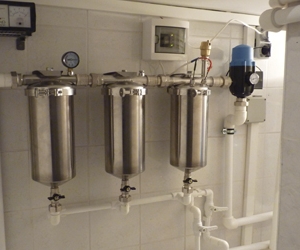
To remove iron compounds, non-reagent filters are installed, based on the principle of oxidation of iron with oxygen from a dissolved form to a solid state, followed by separation of the resulting suspension.
Carbon filters will help reduce the content of hydrogen sulfide in the well and well, cleaning occurs by adsorption.
How to clean sand from well water
The removal of sand or particles of clay, silt, and other large particles occurs on a filter lowered into the well. This is done using simple mechanical filters - lamellar or sandy, and this stage is called the coarse cleaning stage.
If you weigh a lot, one filter is not enough: it will quickly become clogged. It is more practical to put a system with cells of different sizes. For example, water from a well enters a filter that captures particles up to 100 microns in size, then a filter with a purification rate of up to 20 microns is installed. They will remove almost all mechanical impurities.
Filter types
Filters for coarse water purification from a well are: mesh, cassette (cartridge) or backfill. Mesh are most often placed in the well itself. They are a hollow pipe with a slightly smaller diameter than the wellbore.Holes were drilled in the walls of the pipe or slots were made (the shape of the holes depends on the soil), a wire is wound on top, and a mesh is wound along it. The mesh cell is selected depending on the type of soil in the aquifer: it must retain the bulk of the contaminants and at the same time not be clogged. At this stage, the largest impurities are retained, which, moreover, can damage the pump. But some of the solid particles still rise to the surface. They are removed during further water treatment.
Screen filters are installed in wells. They filter out sand and other coarse impurities
Sometimes it is not possible to put a filter in the well. Then all cleaning is transferred to the surface. In this case, cassette or backfill filters are used to purify water from a well. There is a replaceable cartridge in cassettes - a system of membranes, crushed charcoal, etc. on which sand and other large contaminants settle.
Cartridges get clogged from time to time and need to be replaced. The frequency depends on the degree of water pollution and the intensity of its use. Sometimes one cartridge becomes clogged quickly. In this case, it makes sense to install two filters with different degrees of purification. For example, the first one delays particles up to 100 microns, and the one behind it is already up to 20 microns. So the water will be clean and the cartridges will have to be changed less often.
One of the types of water filter cartridges in a private house
In bulk filters, loose filter material is poured into the container - sand, crushed shell, special filtrates (for example, BIRM (BIRM)). The simplest mechanical filter is a sand barrel with a flushing function. One caveat: in the presence of a large amount of dissolved iron, it is still preferable to fill in a special filtrate, it is also a catalyst that oxidizes the dissolved iron and manganese, causing them to precipitate.
Depending on the particle size of the backfill of such a filter, quite small particles can be retained. Sometimes they put two such filters in a row, only with different filling - first, water enters the one where the filtrate is large, then with a finer filling. Bulk filters for purifying water from a well are good because they require replacement of the backfill approximately every three years. And in this they differ from lamellar ones, the filter of which must be changed much more often: sometimes once a month, sometimes once every three to six.
But in order for cleaning with a back-up filter to be effective, they need periodic washing of the filtrate. This usually happens by shutting off some faucets and opening others. In this case, the water flows in the other direction, washing away the main amount of accumulated precipitation.
The principle of water purification in the charge filter
An example of the assembly of two sequential filters for cleaning water from a well from coarse impurities, see the video.
How to make a bailer to clean the well can be read here.
Water purification from lime folk methods
The first group of methods that have found wide application among the people include the following:
settling
The liquid must be poured into a container, left overnight, then drain 2/3 into another clean container. The remaining 1/3 contains all kinds of impurities (sand, lime, iron)
It is important that this option can also be used to remove impurities from tap water, since all the chlorine will evaporate overnight. However, with this method, a lot of time is required, besides, water will constantly have to be poured, and it is difficult to remove impurities from a large volume.
Boiling
The second most common and simple method of purification is boiling. To achieve the result, the liquid must be boiled for 10-15 minutes. During this time, harmful microorganisms will disappear, and lime will precipitate.The disadvantages include the problematic descaling, as well as, as in the case of settling, low productivity.
Freeze
An enameled pan filled with water should be put in the freezer. After half of the water freezes, pull out the resulting ice. He is the target. Dirt should accumulate in the middle, pour boiling water into this place, the dirt will melt and leave. The remaining ice is perfectly clean, melt it and use water. True, such water has one drawback - it contains a minimum of useful substances. For enrichment with salts, mineral water is used, adding in a proportion of 100 ml. mineral water to 1 liter. melt water.
Activated carbon cleaning
Activated carbon is actively used by manufacturers of household filters. Five tablets must be wrapped in gauze and placed in a saucepan overnight. Coal will not only clean the impurities contained in hard water, but also get rid of odors.
This is interesting: Mercury 201 meter connection: short and clear
Boiling and mechanical filtration
An example of the operation of backfill filters for water purification
As you know, when boiling lime water, calcium salts are collected in the form of scale on the bottom and walls of the tank. This is the simplest, easiest and most affordable method for doing it yourself. However, a lot of water cannot be purified in this way. The disadvantages of this cleaning technique include low efficiency and difficulties with descaling.
Most often, mechanical filtration is used to purify water from a well or a private well. It is suitable for removing particles as small as 5 µm. For the event, you will need a special lime water filter. The simplest option is to use backfill filter beds with automatic flushing. In such devices, different materials can be used as backfill: activated carbon, quartz sand, shungite.
The disadvantages of bulk filters include the following:
- the method is effective only for removing particles larger than 20 microns;
- too bulky design of the filter device (average 1.6 m x 26 cm);
- high price.
Example of a disc filter with a replaceable cartridge
Replaceable filtration cartridges have become a good alternative to these devices. They are made from expanded polypropylene. Such devices guarantee high quality cleaning - from 5 microns. Such cartridges can be installed in any filtration units or in multi-cartridge devices. The only drawback is the need to change cartridges frequently.
To purify water from a well or borehole in a volume of 4 to 800 m³ / h, disc filters with automatic flushing can be used. They are suitable for particle sizes from 5 to 500 µm. The main disadvantages of such devices:
- high cost;
- the need to provide the required pressure of water for washing.
The benefits include:
- small size of the unit;
- full automation of the process;
- high degree of efficiency.
How to purify water
You can lower the concentration of iron compounds yourself in several ways. The cleaning method depends on the volume of fluid consumed and how many impurities it contains.
settling
The easiest way to clean up a resource extracted from a well. An additional reservoir is being built, designed for the volume of the expected fluid consumption per day, and sediment occurs in it.
pros
- A simple, cost-effective way
- There is always a supply of clean water.
- Installing a tank in the attic will create gravity. And rid the water of hydrogen sulfide.
Minuses
- Cleaning is not complete
- The container must be periodically cleaned, which is not very convenient, since it requires disconnection from the system.
- Closely monitor the amount of fluid consumed.
Aeration
The precipitated precipitate at the outlet after cleaning is captured by mechanical filters.
- Free-flow - Water contacts oxygen to the maximum, this is due to atomization. Atomizers move liquid into a reservoir. For more productive cleaning in the tank, if necessary, a compressor is installed.
- Pressure type of cleaning - involves the flow of fluid into the system under high pressure. Working in parallel, the pressure and the compressor create bubbling and foaming, which allows the liquid to contact the air as much as possible.
In addition to removing iron, the aeration method eliminates hydrogen sulfide.
- The main advantage of this cleaning is environmental friendliness. The process eliminates the use of reagents.
- Flaws. There is still a certain amount of iron in the water. The operation of the system depends on the availability of electricity. Periodically it is necessary to clean the container and filters.
Ozonation
The process is efficient but labor intensive.
The use of chlorine is a thing of the past. After cleaning with this reagent, it partially remains in the liquid and is harmful to humans and the environment.
Ozonation is considered to be the most reliable method, the effectiveness of which is created by the action of ozone and its derivatives on impurities contained in water.
Organic iron is removed from the liquid by cumulative action. The process of cleaning extracted fluid from a well by ozonation is quite complicated. Requires installation of expensive equipment. An accurate calculation is necessary for productive work, it is very difficult to do it on your own (you need to calculate how much ozone is needed and the time of its exposure to water in accordance with the amount and type of impurities contained in it).
Ion exchange
Such cleaning is carried out by filters containing resin and free ions. As the water passes through the filter, sodium ions are swapped with iron ions. Therefore, the method is called ion exchange.
When the filter has used up all its resources, they must be restored.
Reverse osmosis
Purification of water from iron and impurities is done by a filter containing a membrane, it is she who performs filtration at the molecular level. The reverse osmosis method of iron removal is considered the most productive. Dissolved particles are removed. To improve the quality of filtration and stop the failure of the membrane, it is necessary to pre-purify the water with mechanical filters.
Reverse osmosis completely purifies water from all types of pollution. The method is the most effective, but very expensive.
The work of microfiltration, nano- and ultra- membranes is similar to reverse osmosis.
Introduction of reagents and catalysts
The use of chemical reagents for liquid iron removal is mainly used in industry. Fluid needs to be cleaned up. It is required to remove chemical compounds. The principle is similar for all cleaning systems - a chemical reaction occurs between the iron and the reagent, as a result of which a precipitate forms.
Catalysts are used together with aerated water or with the use of reagents for the oxidation of iron.
The catalytic method of deironing water occurs with the help of filters containing a material with catalytic properties. Water passes through porous fillers, which provide high-quality cleaning.
Research of water from wells
Sampling frequency
According to the norms of SanPiN, clause 2.2.3, monthly surveys are provided for surface layers for legal entities. Owners of private wells do not need such frequent access to specialists without good reason. For wells, the document provides for analyzes every quarter. New sources are tested at the beginning of operation and immediately after installation of the treatment system.If you get good results at the end of each season, then it is enough to control the point once a year. For water intake, certain rules must be followed, otherwise the final data will be unreliable.
By doing an express analysis, you will get a sufficient result if your well is deeper than a hundred meters (artesian) and there are no changes in the properties of the water. In other cases, it is worth doing a detailed analysis, especially the upper soil layers.
Tasks of laboratory research
1. Making a decision on the possibility of using this water as drinking water. This aspect is especially relevant when buying a cottage or land for a summer residence. 2. Obtaining a result on chemical, bacteriological characteristics to select a filtration method to the desired indicators. 3. Evaluation of the work of treatment systems, their effectiveness. 4. Monitoring parameters.
When to do an analysis
- Drilling a new well.
- Decrease in pressure, level, quality for unknown reasons.
- Neighborhood with industrial or agricultural facilities.
- Emergencies: penetration of sewage, sewer liquids, release of excess toxic gases into the air near the site.
Expert advice
To ensure that the parameters of the dynamic and statistical level do not critically change for the worse over time, it is necessary to periodically carry out maintenance. For this, regular water sampling for laboratory analysis should be carried out. This is especially required if an unpleasant odor appears or the color changes.
Also, experts do not advise to develop the well on their own. It is better if it is dug by professional workers. In this case, a passport will be issued with all the necessary data on its condition entered into it. Each company issues a passport according to its own model, but the main columns for all performers are the same.
When operating a well, it is necessary to use serviceable equipment. In this case, its uninterrupted operation for a long time is possible.
It is important to remember that repairing wells comes with costs and some risks. The ultimate goal of all manipulations related to level measurements is to provide the site with clean and fresh water of good quality.
conclusions
As you can see, the most versatile well water purification systems are reverse osmosis systems, which remove almost all types of impurities simultaneously (with the exception of dissolved gases) and provide a stable quality of purification.
There are problems that cannot be dealt with without reverse osmosis: salt water, removal of chlorides and sulfates, nitrates, boron. In general, reverse osmosis removes 97-99% of all impurities present from the water. Water as pure as reverse osmosis is difficult to obtain with other methods.
Among the impurities most commonly found in wells, only hydrogen sulfide is not removed by reverse osmosis. This is due to the fact that the reverse osmosis system effectively retains charged particles, but passes uncharged particles comparable in size to water molecules, in particular gases. Therefore, if hydrogen sulfide is present in the well, it will be necessary to install an activated carbon filter after the reverse osmosis system. It should also be remembered that in case of very high water pollution with suspended particles or hardness salts, in order to ensure efficient and long-term operation of reverse osmosis systems, it is advisable to install a block pretreatment of water before reverse osmosis.
As soon as the well is prepared, the first step is to take a water sample for analysis to an accredited laboratory and find out what unwanted impurities and in what concentration are present in your water. With the result of water analysis, contact us - experienced water treatment specialists will advise you on any problem related with water for your home.
For consultation with our specialists, call us or send an application:
You can find water purification equipment for the home in the section Water purification systems
We invite you to sign up for a demonstration of the operation of a membrane water treatment system, and our specialists will come to you at any time convenient for you.You will be able to see what the water in your house will look like if it is purified using our equipment. Departure of experts and demonstration of work of the equipment are free.
Drink clean water and be healthy!
We recommend reading:
